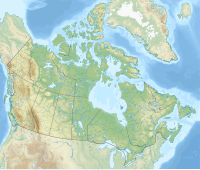Whitehorn Mountain (Alberta)
Appearance
| Whitehorn Mountain | |
|---|---|
 Whitehorn Mountain seen beyond Chateau Lake Louise | |
| Highest point | |
| Elevation | 2,621 m (8,599 ft)[1] |
| Prominence | 167 m (548 ft)[1] |
| Parent peak | Mount Richardson |
| Listing | Mountains of Alberta |
| Coordinates | 51°28′0″N 116°08′17″W / 51.46667°N 116.13806°W |
| Geography | |
| Location | Alberta, Canada |
| Parent range | Slate Range Canadian Rockies |
| Topo map | NTS 82N8 Lake Louise |
| Climbing | |
| First ascent | 1884 A.P. Coleman |
Whitehorn Mountain is located in the Slate Range of Banff National Park in Alberta, Canada.[1]
Geology
Like other mountains in Banff Park, Whitehorn is composed of sedimentary rock laid down from the Precambrian to Jurassic periods.[2] Formed in shallow seas, this sedimentary rock was pushed east and over the top of younger rock during the Laramide orogeny.[3]
Climate
Based on the Köppen climate classification, Whitehorn is located in a subarctic climate zone with cold, snowy winters, and mild summers.[4] Temperatures can drop below -20 °C with wind chill factors below -30 °C.
See also
References
- ^ a b c "Whitehorn Mountain". Bivouac.com. Retrieved 2019-06-11.
- ^ Belyea, Helen (1960). "The Story of the Mountains in Banff National Park" (PDF). Geological Survey of Canada. Archived (PDF) from the original on 2 October 2015. Retrieved 2019-05-05.
- ^ Gadd, Ben (2008). "Geology of the Rocky Mountains and Columbias".
{{cite journal}}: Cite journal requires|journal=(help) - ^ Peel, M. C.; Finlayson, B. L.; McMahon, T. A. (2007). "Updated world map of the Köppen−Geiger climate classification". Hydrol. Earth Syst. Sci. 11 (5): 1633–1644. Bibcode:2007HESS...11.1633P. doi:10.5194/hess-11-1633-2007. ISSN 1027-5606. S2CID 9654551.
External links
- National Park Service web site: Banff National Park
- Whitehorn Mountain weather: Mountain Forecast


